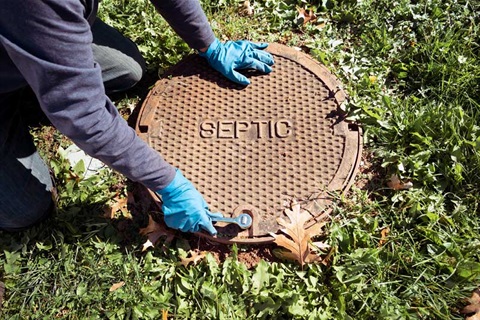Septic Tank Trench Failure

What is a Septic Tank Trench?
The absorption trench is where effluent flows after it leaves the septic tank. An archway or perforated pipe is laid in a gravel trench and covered with soil. Effluent seeps through the archway or pipe and is absorbed by the soil which disposes of the effluent liquid and provides further treatment to the effluent, reducing pollutants and pathogens.
What is a failed trench?
A trench has failed when it is unable to move the effluent below ground, causing liquid to rise to the surface. This can happen because the trench is blocked, or if the surrounding soil is already waterlogged. This causes pooling water or excessive moisture around the trench. The area may also have a strong smell or have a large amount of dense grass.
Trenches can fail due to the age, lack of maintenance, location, or construction issues. Absorption trenches should last for 15-25 years, but this can drop to as little as two years if they are not built and maintained properly.
So, the trench has failed. What now?
The first step is to have a site and soil assessment, also known as a Geo-Tech report. This report must be prepared by a suitably qualified professional. There are several local companies that conduct these assessments. The assessment will identify a suitable location for a replacement trench, or recommend an alternative system as required.
How is a trench installed?
There are two main types of septic trenches installed in this region – the self-supporting arched liner type, and the perforated pipe type. The size of a new trench depends on the number of bedrooms or potential bedrooms (e.g. a study or home office) in a house. This information will be found in the site and soil report. A house with more than one bedroom will typically require multiple trenches, and no single trench can be longer than 20 metres. Multiple trenches can be connected through a distribution box with at least 2 metres between each trench.
A trench must comply with AS/NZS 1547:2012 and the Environment and Protection Guidelines - On-Site Sewage Management for Single Households (1998). Depending on your area, WaterNSW may also have requirements to meet.
As trenches must be installed in specific ways using specific equipment, it is recommended that new trenches be constructed by an appropriately qualified person. If a trench is installed correctly, there is a high risk of the trench failing quickly and causing environmental or public health issues.
What if I want to install an AWTS instead?
An Aerated Wastewater Treatment System (AWTS) can be installed if you have a suitable site as per your site and soil assessment. A Commissioning Certificate will need to be provided by the installer with evidence of a service contract. This should also record the status of your tank (retaining existing tank, or replacing with a new tank).
What approvals are needed?
You will need to apply to alter or install a wastewater system. This can be submitted to council through the NSW Planning Portal (under the Section 68 approvals section). Once the application has been received, a Council building surveyor will contact you to discuss the application and any required inspections. Works cannot be started until you have received approval from council. Penalties may apply to works undertaken without approval.
What paperwork must be provided?
A NSW Fair Trading Notification of Works certificate is required to be submitted to Council at least 7 days prior to any works commencing. If no inspections are required, (due to a standard trench replacement in an appropriate approved area), the installing plumber or drainer will only need to provide to Council an updated Sewer Service Diagram (SSD) or ‘works as executed’ plans, showing the location of the private sewer pipes and areas of installation on the property; and a NSW Fair Trading Compliance Certificate. This must be provided within 7 days. For a new septic trench installation, this paperwork des not need to be submitted to NSW Fair Trading.
Decommissioning an old system
If an old tank is not being incorporated into a new system, it must be decommissioned. The property owner is required to notify council in writing how the old system will be decommissioned, including information about disposal method and approximate timeline. The decommissioning works must adhere to NSW Health Advisory Note 3: (January 2017) Destruction, Removal or Reuse of Septic Tanks, Collection Wells, Aerated Wastewater Treatment Systems (AWTS) and other Sewage Management Facilities (SMF). This can be found here: https://bit.ly/NSWHealthNote3
What happens if you don’t fix a failed trench?
If works are not completed within 90 days of the failure notification, enforcement action may be undertaken. This may include ongoing fees under Council’s Fees and Charges Schedule, and orders or notices given under legislation. If you are unable to complete works within the timeframe, you need to contact Council and provide details of the delay and ask for an extended timeframe.
Section 124 of the Local Government Act (1993) empowers council to issue orders requiring work to be completed. If no action is taken within the given timeframe, a penalty notice of $330 may be issued. Council also has the option to engage an external contractor to have works completed, and recover the cost from the property owner.
If a significant risk is posed, a prevention notice may also be issued under the Protection of the Environment Operations Act (1997). This comes with an administrative fee of $785. If a prevention notice is not complied with, the initial maximum penalty for individuals is $500,000, and a further $120,000 per day can be imposed by the Courts. Council may further issue a penalty of $15,000 for a first offence, and $22,500 for ongoing offences.